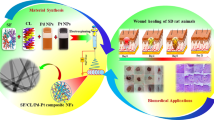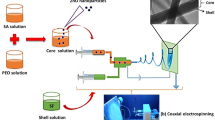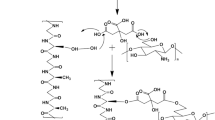Abstract
Curcumin exhibited excellent properties including antioxidant, antiinflammatory, antiviral, antibacterial, antifungal, anticancer, and anticoagulant activities. In this study, curcumin was incorporated into silk fibroin (SF)/poly(L-lactic acid-co-e-caprolactone) (P(LLA-CL)) nanofibrous scaffolds via electrospinning, and changes brought about by raising the curcumin content were observed: SEM images showed that the average nanofibrous diameter decreased at the beginning and then increased, and the nanofibers became uniform; FTIR showed that the conformation of SF transforming from random coil form to β-sheet structure had not been induced, while SF conformation converted to β-sheet after being treated with 75% ethanol vapor; XRD results confirmed that the crystal structure of (P(LLA-CL)) had been destroyed; The mechanical test illustrated that nanofibrous scaffolds still maintained good mechanical properties. Further, curcumin-loaded nanofibrous scaffolds were evaluated for drug release, antioxidant and antimicrobial activities in vitro. The results showed that curcumin presented a sustained release behavior from nanofibrous scaffolds and maintained its free radical scavenging ability, and such scaffolds could effectively inhibit S. aureus growth (> 95%). Thus, curcumin-loaded SF/P(LLA-CL) nanofibrous scaffolds might be potential candidates for wound dressing and tissue engineering scaffolds.
Similar content being viewed by others
References
Ammon H P, Wahl M A. Pharmacology of Curcuma longa. Planta Medica, 1991, 57(1): 1–7
Gopinath D, Ahmed M R, Gomathi K, et al. Dermal wound healing processes with curcumin incorporated collagen films. Biomaterials, 2004, 25(10): 1911–1917
Basnet P, Skalko-Basnet N. Curcumin: an anti-inflammatory molecule from a curry spice on the path to cancer treatment. Molecules, 2011, 16(6): 4567–4598
Anand P, Kunnumakkara A B, Newman R A, et al. Bioavailability of curcumin: problems and promises. Molecular Pharmaceutics, 2007, 4(6): 807–818
Kasoju N, Bora U. Fabrication and characterization of curcuminreleasing silk fibroin scaffold. Journal of Biomedical Materials Research Part B: Applied Biomaterials, 2012, 100(7): 1854–1866
Pan C J, Shao Z Y, Tang J J, et al. In vitro studies of platelet adhesion, activation, and protein adsorption on curcumin-eluting biodegradable stent materials. Journal of Biomedical Materials Research Part A, 2007, 82(3): 740–746
Brahatheeswaran D, Mathew A, Aswathy R G, et al. Hybrid fluorescent curcumin loaded zein electrospun nanofibrous scaffold for biomedical applications. Biomedical Materials, 2012, 7(4): 045001
Gupta V, Aseh A, Ríos C N, et al. Fabrication and characterization of silk fibroin-derived curcumin nanoparticles for cancer therapy. International Journal of Nanomedicine, 2009, 4: 115–122
Ali M M, Sarasa Bharati A A. Effect of crude extract of Bombyx mori coccoons in hyperlipidemia and atherosclerosis. Journal of Ayurveda and Integrative Medicine, 2011, 2(2): 72–78
Murphy A R, St John P, Kaplan D L. Modification of silk fibroin using diazonium coupling chemistry and the effects on hMSC proliferation and differentiation. Biomaterials, 2008, 29(19): 2829–2838
Zhang K, Wang H, Huang C, et al. Fabrication of silk fibroin blended P(LLA-CL) nanofibrous scaffolds for tissue engineering. Journal of Biomedical Materials Research Part A, 2010, 93(3): 984–993
Zhang K H, Ye Q, Yan Z Y. Influence of post-treatment with 75% (v/v) ethanol vapor on the properties of SF/P(LLA-CL) nanofibrous scaffolds. International Journal of Molecular Sciences, 2012, 13(2): 2036–2047
Zhang K H, Wu J L, Huang C, et al. Fabrication of silk fibroin/P (LLA-CL) aligned nanofibrous scaffolds for nerve tissue engineering. Macromolecular Materials and Engineering, 2013, 298(5): 565–574
Wang C Y, Zhang K H, Fan C Y, et al. Aligned natural-synthetic polyblend nanofibers for peripheral nerve regeneration. Acta Biomaterialia, 2011, 7(2): 634–643
Blois M S. Antioxidant determinations by the use of a stable free radical. Nature, 1958, 181(4617): 1199–1200
Kim K, Luu Y K, Chang C, et al. Incorporation and controlled release of a hydrophilic antibiotic using poly(lactide-co-glycolide)-based electrospun nanofibrous scaffolds. Journal of Controlled Release, 2004, 98(1): 47–56
Suwantong O, Opanasopit P, Ruktanonchai U, et al. Electrospun cellulose acetate fiber mats containing curcumin and release characteristic of the herbal substance. Polymer, 2007, 48(26): 7546–7557
Sun X Z, Williams G R, Hou X X, et al. Electrospun curcuminloaded fibers with potential biomedical applications. Carbohydrate Polymers, 2013, 94(1): 147–153
Chen X, Shao Z, Marinkovic N S, et al. Conformation transition kinetics of regenerated Bombyx mori silk fibroin membrane monitored by time-resolved FTIR spectroscopy. Biophysical Chemistry, 2001, 89(1): 25–34
Tsuji H, Mizuno A, Ikada Y. Enhanced crystallization of poly-(L-lactide-co-ecaprolactone) during storage at room temperature. Journal of Applied Polymer Science, 2000, 76(6): 947–953
Asakura T, Kuzuhara A, Tabeta R, et al. Conformational characterization of Bombyx mori silk fibroin in the solid state by high-frequency 13C cross polarization-magic angle spinning NMR, X-ray diffraction, and infrared spectroscopy. Macromolecules, 1985, 18(10): 1841–1845
Zhang K H, Yin A L, Huang C, et al. Degradation of electrospun SF/P(LLA-CL) blended nanofibrous scaffolds in vitro. Polymer Degradation & Stability, 2011, 96(12): 2266–2275
Hu M, Peng W, Li H J. Application of silk protein and its derivatives in cosmetics. Detergent and Cosmetics, 2011, 34: 34–39
Sharma O P. Antioxidant activity of curcumin and related compounds. Biochemical Pharmacology, 1976, 25(15): 1811–1812
Author information
Authors and Affiliations
Corresponding author
Rights and permissions
About this article
Cite this article
Lian, Y., Zhan, JC., Zhang, KH. et al. Fabrication and characterization of curcumin-loaded silk fibroin/P(LLA-CL) nanofibrous scaffold. Front. Mater. Sci. 8, 354–362 (2014). https://doi.org/10.1007/s11706-014-0270-8
Received:
Accepted:
Published:
Issue Date:
DOI: https://doi.org/10.1007/s11706-014-0270-8




